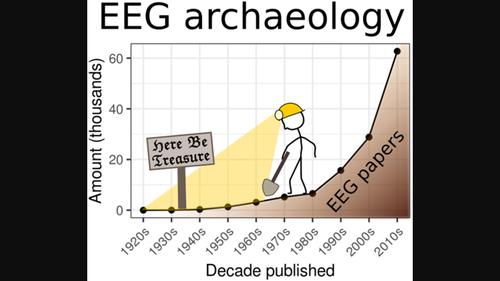当前位置:
X-MOL 学术
›
Eur. J. Neurosci.
›
论文详情
Our official English website, www.x-mol.net, welcomes your
feedback! (Note: you will need to create a separate account there.)
Forgotten rhythms? Revisiting the first evidence for rhythms in cognition
European Journal of Neuroscience ( IF 2.7 ) Pub Date : 2021-09-08 , DOI: 10.1111/ejn.15450 Cliodhna Quigley 1, 2, 3
European Journal of Neuroscience ( IF 2.7 ) Pub Date : 2021-09-08 , DOI: 10.1111/ejn.15450 Cliodhna Quigley 1, 2, 3
Affiliation

|
Practically every neuroscientist knows that human brain rhythms were first recorded in the 1920s by Hans Berger, who coined the term ‘alpha waves’ for the regular activity of around 10 cycles per second that was clearly visible in many of his recordings. Almost 100 years later, alpha rhythms are still the subject of active investigation and continue to intrigue researchers. What we have perhaps forgotten though, is the clever experimentation that was carried out during the first decades of electroencephalogram (EEG) research, often using sophisticated, custom-made analysis and stimulation devices. Here, I review selected findings from the early EEG literature regarding the character, origin, and meaning of human brain rhythms, beginning with Berger's publications and then focusing on the use of regular visual stimulation as a tool to understand intrinsic brain rhythms. It is clear that many of these findings are still relevant to open questions about the role of rhythmic brain activity. In addition, they also contain some general lessons for contemporary neuroscientists, meaning that there is great value in looking back at these forgotten publications.
中文翻译:

忘记节奏?重新审视认知节律的第一个证据
事实上,每一位神经科学家都知道,人类大脑节律是由汉斯·伯杰 (Hans Berger) 在 20 年代首次记录的,他创造了“阿尔法波”一词,指的是每秒约 10 个周期的常规活动,这在他的许多记录中都清晰可见。近 100 年后,α 节律仍然是积极研究的主题,并继续引起研究人员的兴趣。但我们可能忘记的是,在脑电图 (EEG) 研究的最初几十年中进行的巧妙实验,通常使用复杂的定制分析和刺激设备。在这里,我回顾了早期脑电图文献中关于人类大脑节律的特征、起源和意义的精选研究结果,从伯杰的出版物开始,然后重点讨论使用常规视觉刺激作为理解内在大脑节律的工具。显然,其中许多发现仍然与有关大脑节律活动的作用的悬而未决的问题相关。此外,它们还为当代神经科学家提供了一些一般性的教训,这意味着回顾这些被遗忘的出版物具有很大的价值。
更新日期:2021-09-08
中文翻译:

忘记节奏?重新审视认知节律的第一个证据
事实上,每一位神经科学家都知道,人类大脑节律是由汉斯·伯杰 (Hans Berger) 在 20 年代首次记录的,他创造了“阿尔法波”一词,指的是每秒约 10 个周期的常规活动,这在他的许多记录中都清晰可见。近 100 年后,α 节律仍然是积极研究的主题,并继续引起研究人员的兴趣。但我们可能忘记的是,在脑电图 (EEG) 研究的最初几十年中进行的巧妙实验,通常使用复杂的定制分析和刺激设备。在这里,我回顾了早期脑电图文献中关于人类大脑节律的特征、起源和意义的精选研究结果,从伯杰的出版物开始,然后重点讨论使用常规视觉刺激作为理解内在大脑节律的工具。显然,其中许多发现仍然与有关大脑节律活动的作用的悬而未决的问题相关。此外,它们还为当代神经科学家提供了一些一般性的教训,这意味着回顾这些被遗忘的出版物具有很大的价值。











































 京公网安备 11010802027423号
京公网安备 11010802027423号